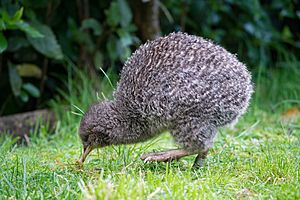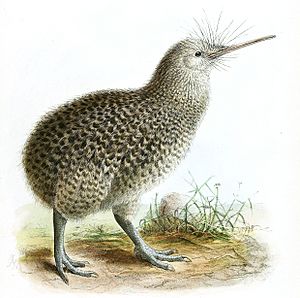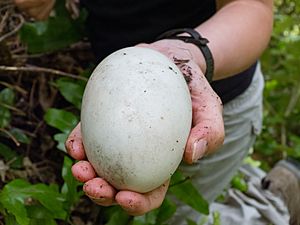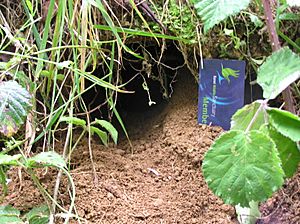Little spotted kiwi facts for kids
The little spotted kiwi, also known as the little grey kiwi, is a small bird from New Zealand. It's special because it can't fly! This bird is the smallest of all five kiwi species. It weighs about 0.9 to 1.9 kilograms (2 to 4.2 pounds), which is about the size of a small chicken.
Long ago, little spotted kiwis lived on both main islands of New Zealand. But now, they mostly live on small islands and in special protected areas on the mainland. These areas are safe because they have fences that keep out animals that might harm the kiwi.
Quick facts for kids Little spotted kiwi |
|
|---|---|
 |
|
| Foraging at Zealandia EcoSanctuary, Wellington | |
| Conservation status | |
| Scientific classification | |
| Genus: |
Apteryx
|
| Species: |
owenii
|
 |
|
| The distribution of little spotted kiwi.
Predator-free islands:
Mainland:
|
|
Contents
About the Little Spotted Kiwi
The little spotted kiwi is a type of bird called a ratite. Ratites are birds that cannot fly, like ostriches and emus. Its scientific name is Apteryx owenii. Apteryx means "without wings," and owenii is a tribute to Sir Richard Owen, a famous scientist.
This kiwi was first described in 1847 by a scientist named John Gould. The first specimen, or example, of the bird was sent to England.
What They Look Like
Little spotted kiwis are about 35 to 45 centimeters (14 to 18 inches) long. Males weigh between 0.88 and 1.36 kilograms (1.9 to 3 pounds). Females are a bit heavier, weighing from 1 to 1.95 kilograms (2.2 to 4.3 pounds). This makes them the smallest kiwi species.
Their feathers are a pale, mottled grey with fine white spots, giving them a shaggy look. They don't have a tail, but they do have long, stiff feathers around their beak that act like whiskers. Their beak is long and ivory-colored, and their legs are pale.
Where They Live
Studies on Kapiti Island, one of the places they live, show that little spotted kiwis like habitats with flax plants, new forests, and older forests. Fewer kiwis are found in open grasslands or scrubby areas. This suggests they prefer the protection and food found in denser plant areas.
How They Behave
Little spotted kiwis mostly eat grubs and small insects found underground. Sometimes, they also eat berries. They use their strong claws and long beaks to dig into the soft ground. Then, they push their long beak deep into the soil to find food.
Since they can't fly and have very poor eyesight, they rely on their excellent sense of smell. Their long beak and sharp talons are also very important for finding food. These kiwis are nocturnal, meaning they are active at night.
Little spotted kiwis call out at night to mark their territory and to stay in touch with their partners. Often, a pair of kiwis will sing a duet together. They are very protective of their territory and will fight other kiwis with their sharp claws.
Reproduction and Life Cycle
Little spotted kiwis build their nests in burrows they dig themselves. Both the male and female birds help dig the burrow. Sometimes, they line the nest with plant material to make it cozy.
Eggs are laid from July to January. A female kiwi usually lays one or two eggs. The male kiwi then incubates, or sits on, the eggs for about 63 to 76 days until they hatch. After hatching, the young kiwis stay in the nest for two to three weeks. They need to be fed for about four weeks.
The egg of a little spotted kiwi is huge compared to the size of the bird! It can be about 26 percent of the mother's body weight. Imagine a human woman giving birth to a six-year-old child – that's how big the egg is in comparison!
Conservation Efforts
| Location | Population | Date | Trend |
|---|---|---|---|
| Hen Island | 50 | 2012 | Increasing |
| Kapiti Island | c.1200 | 2012 | Stable |
| Red Mercury Island | 70 | 2012 | Increasing |
| Long Island | 50 | 2012 | Increasing |
| Tiritiri Matangi | 80 | 2012 | Increasing |
| Zealandia Wildlife Sanctuary | 120 | 2012 | Increasing |
| Motuihe Island | 30 | 2012 | Stable |
| Anchor Island | 20 | 2015 | Increasing |
| Chalky Island | 50 | 2012 | Stable |
| Total (New Zealand) | 1670 | 2012 | Increasing |
In the past, little spotted kiwis were common in parts of the South Island. But then, many were hunted for their skins, which were sent to museums in Europe. As more European settlers arrived, kiwis were also hunted for food. Their numbers also dropped because of introduced animals like dogs and cats.
By 1938, little spotted kiwis were gone from the North Island. The last four birds from the South Island were moved to Kapiti Island to help protect them. From Kapiti Island, they were moved to other safe islands like Red Mercury Island, Hen Island, Tiritiri Matangi Island, Chalky Island, and Long Island.
In 2000, about 20 little spotted kiwis were released into Karori Wildlife Sanctuary. This was a big moment because it was the first time in over a century that these kiwis lived on the North Island mainland again! In 2015, 20 more kiwis were moved from Kapiti Island to Anchor Island.
Because they are so small, little spotted kiwis are very vulnerable to predators like cats, dogs, and stoats. However, most of them now live on special island reserves, like Kapiti Island, where these introduced predators are mostly absent.
The little spotted kiwi's population is growing, which is great news! While they are not considered rare, their small range means they still need protection. The fact that they live in areas without many predators, except for the weka (another native bird), is very important for their increasing numbers. In 2012, it was estimated that there were about 1600 little spotted kiwis.
See also
 In Spanish: Kiwi moteado menor para niños
In Spanish: Kiwi moteado menor para niños





